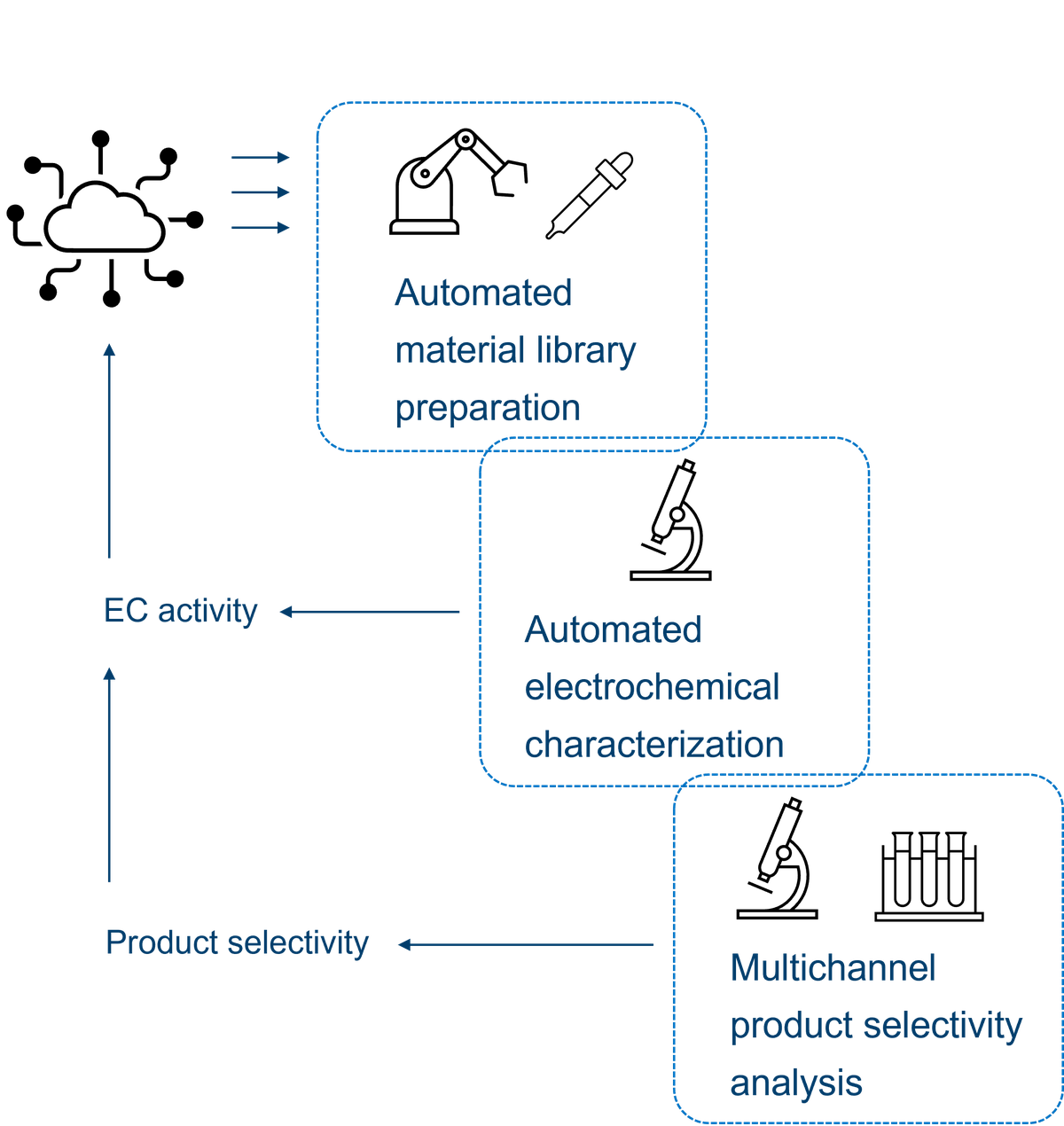Light-2-X Lab
About
At Light-2-X Lab, we are advancing the future of clean energy by integrating photovoltaics with both short- and long-duration storage technologies to enable uninterrupted solar power. Spanning from high-throughput autonomous material discovery to device-level integration, our team merges photovoltaics expertise with electrochemistry to create efficient, sustainable, and resilient combinations of PV with batteries and electrolyzers that transform CO₂ and water into valuable fuels and chemicals.
Research Topics
- Accelerated autonomous material discovery beyond PV
- Materials and devices for PV-driven CO₂ and H₂O conversion
- Integrated PV-battery devices from room to field
- Photovoltaic-battery-electrolyzer hybrids
Accelerated autonomous material discovery beyond PV

The accelerated autonomous discovery of materials beyond photovoltaics (PV) is based on the newly designed High-Throughput Characterization Platform (HTCP), which primarily focuses on materials for CO₂ reduction and water splitting. Leveraging the achievements of the photovoltaic material discovery platform, existing and new libraries of earth-abundant material compounds are tested for applications beyond PV, in electrocatalysis and photoelectrocatalysis. The HTCP's parallel synthesis and rapid electrochemical evaluation are aggregated into three core stages: automated, robotized material library preparation; automated electrochemical characterization; and parallel, multichannel product selectivity analysis. This creates a unique opportunity to couple experimental data with predictive machine learning algorithms and explore an enormous landscape of material combinations in an unprecedentedly short time, far surpassing traditional trial-and-error methods.
Materials and devices for PV-driven CO₂ and H₂O conversion

Long-term energy storage in fuels and other chemical carriers is crucial for balancing the seasonal variability of photovoltaic power generation. We tackle this challenge using an 'artificial leaf' approach - converting carbon dioxide (CO₂), water (H₂O), and sunlight into valuable chemical products through direct photovoltaic-driven electrolysis (PV-EC). This development requires the integration of photovoltaic and electrochemical expertise, along with the development of new materials and device concepts that enable sustainable solutions at the terawatt scale. Our work explores diverse PV-EC combinations, with a strong focus on technologies that avoid critical raw materials and that operate under realistic conditions.
Our research focuses on developing methods to design, predict performance, and test these devices under diverse target operating cycles. For experimental studies of PV-EC combinations, we employ flexible procedures supported by unique PV emulation facilities that can reproduce the required current-voltage characteristics for any target irradiance and temperature time series. This approach enables us to evaluate novel electrochemical materials and devices within their intended climatic application context in a controlled and reproducible manner.
Related Publications
Integrated PV-battery devices from room to field

We pursue a simple, scalable, and highly efficient concept of direct coupling and integrating PV devices with batteries for applications ranging from indoor internet-of-things to full scale outdoor PV modules. Using modeling, small-scale experiments, and full-scale outdoor prototypes, we demonstrate excellent power matching in PV-battery devices across a wide range of irradiance, temperature, and load conditions. In close collaboration within Forschungszentrum, we aim to achieve deep integration of PV-battery devices and to enhance their performance, safety, stability, and sustainability by exploring novel material combinations and advanced integration technologies.
Related Publications
Photovoltaic-battery-electrolyzer hybrids

To simultaneously address short- and long-term energy storage challenges, we study direct-coupled photovoltaic-electrolyzer-battery (PV-EC-B) hybrids. Our research, both theoretical and experimental, has demonstrated the feasibility of self-sustained, power-electronics-free operation of these PV-EC-B units. Integrating electrochemical and battery storage not only ensures stable power transfer and uninterrupted electrolyzer operation but also improves solar-to-chemical efficiency, even in the presence of inherent battery losses. The synergy can boost the solar-to-chemical efficiency of the hybrid device beyond the theoretical limit of the PV-EC reference. The magnitude of the efficiency gain and the implications of this synergy for the long-term performance of electrochemical materials are at the core of our ongoing investigations.
Related Publications
Research facilities
PV emulator for electrochemistry

When conducting practical tests of PV-driven electrochemistry, researchers often face limitations due to the conditions in their labs or testing sites. Experimental devices may be limited to laboratory environments, making coupling to physical photovoltaics impractical. To avoid these limitations, we use a custom-designed tool: the PV emulator, which is built using common functions available in off-the-shelf laboratory power supplies. This PV emulator's software and hardware are capable of physically emulating any required PV IV. This approach offers maximum flexibility in selecting a photovoltaic module and operating conditions. Using this tool, any time series of IVs can be reproducibly emulated over the required period, bringing electrochemical devices to target real-world operating conditions and representing a unique collaboration opportunity for groups developing such devices.
Related Publication
Thermal chamber for battery testing under realistic PV conditions

To ensure accurate and reliable realistic performance testing of batteries, our Light-2-X laboratory utilizes a custom-designed thermal chamber capable of simulating a wide range of temperature conditions. Engineered specifically for internal R&D projects, the chamber features a fully automated heating and cooling system, allowing precise temperature control from −20 °C to 80 °C. This setup is essential for testing battery behavior under varying thermal environments and has been extensively used to cycle PV-battery units under realistic temperature scenarios.
Outdoor testing of PV-B modules

At the Light-2-X Lab, integrated, direct-coupled PV-battery modules are developed and tested in a real-world outdoor environment. Custom-designed control software ensures the modules operate continuously and safely while enabling adjustable load profiles that reflect realistic consumption scenarios. This setup provides a comprehensive dataset on electrical parameters, and, most importantly, thermal conditions for the PV and battery. This dataset, collected over a period of more than a year, provides a solid foundation for the further development and optimization of direct-coupled PV-battery devices.
















